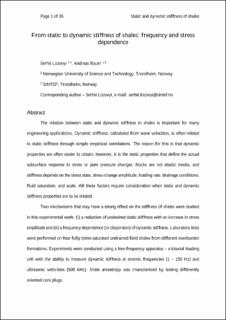| dc.contributor.author | Lozovyi, Serhii | |
| dc.contributor.author | Bauer, Andreas | |
| dc.date.accessioned | 2020-03-27T12:15:32Z | |
| dc.date.available | 2020-03-27T12:15:32Z | |
| dc.date.created | 2019-08-13T14:27:54Z | |
| dc.date.issued | 2019 | |
| dc.identifier.citation | Rock Mechanics and Rock Engineering. 2019, 52 (12), 5085-5098. | en_US |
| dc.identifier.issn | 0723-2632 | |
| dc.identifier.uri | https://hdl.handle.net/11250/2649111 | |
| dc.description.abstract | The relation between static and dynamic stiffness in shales is important for many engineering applications. Dynamic stiffness, calculated from wave velocities, is often related to static stiffness through simple empirical correlations. The reason for this is that dynamic properties are often easier to obtain; however, it is the static properties that define the actual subsurface response to stress or pore pressure changes. Rocks are not elastic media, and stiffness depends on the stress state, stress change amplitude, loading rate, drainage conditions, fluid saturation, and scale. All these factors require consideration when static and dynamic stiffness properties are to be related. Two mechanisms that may have a strong effect on the stiffness of shales were studied in this experimental work: (1) a reduction of undrained static stiffness with an increase in stress amplitude and (2) a frequency dependence (or dispersion) of dynamic stiffness. Laboratory tests were performed on four fully brine-saturated undrained field shales from different overburden formations. Experiments were conducted using a low-frequency apparatus—a triaxial loading cell with the ability to measure dynamic stiffness at seismic frequencies (1–150 Hz) and ultrasonic velocities (500 kHz). Shale anisotropy was characterized by testing differently oriented core plugs. The results demonstrated that all the tested shales exhibited a dispersion of dynamic stiffness from seismic to ultrasonic frequencies. Young’s modulus dispersion for the tested shales ranged from nearly 30% to above 100%. Wave velocity dispersion was on the order of 10–20% for P-waves and 20–40% for S-waves. In static tests, the undrained rock stiffness gradually decreased with increasing stress amplitude. For one shale, the static undrained Young’s modulus was reduced by 50% when amplitude of the loading–unloading measurement cycle increased from 1 to 3 MPa. This finding is explained by non-elastic deformations that increase with the stress level. A method of zero-stress extrapolation of static stiffness was used to obtain the purely elastic response. The stiffness for the limit of zero stress change amplitude agreed well with the dynamic response at seismic frequency, providing a link between static and dynamic stiffness. | en_US |
| dc.language.iso | eng | en_US |
| dc.publisher | Springer | en_US |
| dc.relation.uri | https://link.springer.com/article/10.1007/s00603-019-01934-1 | |
| dc.title | From Static to Dynamic Stiffness of Shales: Frequency and Stress Dependence | en_US |
| dc.type | Peer reviewed | en_US |
| dc.type | Journal article | en_US |
| dc.description.version | acceptedVersion | en_US |
| dc.source.pagenumber | 5085-5098 | en_US |
| dc.source.volume | 52 | en_US |
| dc.source.journal | Rock Mechanics and Rock Engineering | en_US |
| dc.source.issue | 12 | en_US |
| dc.identifier.doi | 10.1007/s00603-019-01934-1 | |
| dc.identifier.cristin | 1715628 | |
| dc.relation.project | Norges forskningsråd: 234074 | en_US |
| dc.relation.project | Norges forskningsråd: 294369 | en_US |
| dc.description.localcode | This is a post-peer-review, pre-copyedit version of an article. Locked until 12.08.1010 due to copyright restrictions. The final authenticated version is available online at: DOI:10.1007/s00603-019-01934-1 | en_US |
| cristin.unitcode | 194,64,90,0 | |
| cristin.unitname | Institutt for geovitenskap og petroleum | |
| cristin.ispublished | true | |
| cristin.fulltext | postprint | |
| cristin.qualitycode | 2 | |
